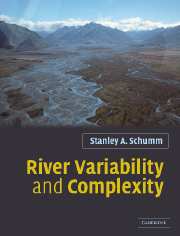Chapter 17 - Length
Published online by Cambridge University Press: 05 June 2012
Summary
Very similar to the effect of base-level change is the effect of lengthening or shortening of a channel (Figure 1.2). This can occur by avulsion, meander cutoffs, and channelization. Shortening the channel will increase gradient and lengthening the channel will decrease gradient. A good example of this is meander change. A cutoff steepens gradient, and an increase of meander amplitude, as it grows, decreases gradient.
The braided rivers of the Canterbury Plains of New Zealand provide an example of fluvial response to increasing gradient caused by shortening of the channel (Leckie, 1994). The Canterbury Plains consist of coalescing alluvial fans, built during glacial episodes by the Rangitata, Ashburton, Rakaia, and Waimakariri rivers. All of these flow from the Southern Alps. Along the coast, the shoreline is retreating by about 1 m per year, and there are wave-cut cliffs up to 25 m high. The rivers are incising by up to 4 mm per year, with zones of incision extending 8–15 km inland. Upstream of this point, there is a zone of negligible incision, where the rivers flow at the original surface of the Plain.
A similar result occurs if a main channel shifts laterally across its floodplain thereby either lengthening or shortening a tributary channel. A lateral shift of a channel from one side of its floodplain to the other shortens streams on one side and lengthens them on the other. This causes degradation on one side and aggradation on the other, as gradients are steepened and made gentler.
- Type
- Chapter
- Information
- River Variability and Complexity , pp. 156 - 160Publisher: Cambridge University PressPrint publication year: 2005



